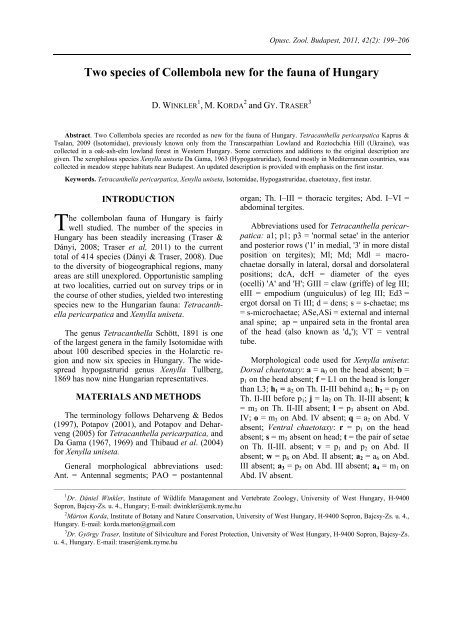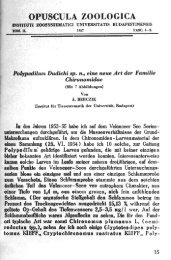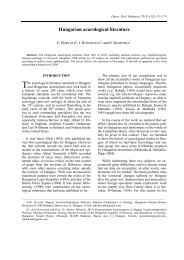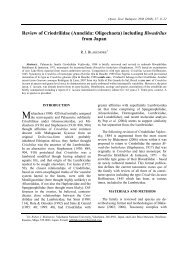Two species of Collembola new for the fauna of Hungary - Opuscula ...
Two species of Collembola new for the fauna of Hungary - Opuscula ...
Two species of Collembola new for the fauna of Hungary - Opuscula ...
Create successful ePaper yourself
Turn your PDF publications into a flip-book with our unique Google optimized e-Paper software.
Opusc. Zool. Budapest, 2011, 42(2): 199–206<br />
<strong>Two</strong> <strong>species</strong> <strong>of</strong> <strong>Collembola</strong> <strong>new</strong> <strong>for</strong> <strong>the</strong> <strong>fauna</strong> <strong>of</strong> <strong>Hungary</strong><br />
D. WINKLER 1 , M. KORDA 2 and GY. TRASER 3<br />
Abstract. <strong>Two</strong> <strong>Collembola</strong> <strong>species</strong> are recorded as <strong>new</strong> <strong>for</strong> <strong>the</strong> <strong>fauna</strong> <strong>of</strong> <strong>Hungary</strong>. Tetracan<strong>the</strong>lla pericarpatica Kaprus &<br />
Tsalan, 2009 (Isotomidae), previously known only from <strong>the</strong> Transcarpathian Lowland and Roztochchia Hill (Ukraine), was<br />
collected in a oak-ash-elm lowland <strong>for</strong>est in Western <strong>Hungary</strong>. Some corrections and additions to <strong>the</strong> original description are<br />
given. The xerophilous <strong>species</strong> Xenylla uniseta Da Gama, 1963 (Hypogastruridae), found mostly in Mediterranean countries, was<br />
collected in meadow steppe habitats near Budapest. An updated description is provided with emphasis on <strong>the</strong> first instar.<br />
Keywords. Tetracan<strong>the</strong>lla pericarpatica, Xenylla uniseta, Isotomidae, Hypogastruridae, chaetotaxy, first instar.<br />
T<br />
INTRODUCTION<br />
he collembolan <strong>fauna</strong> <strong>of</strong> <strong>Hungary</strong> is fairly<br />
well studied. The number <strong>of</strong> <strong>the</strong> <strong>species</strong> in<br />
<strong>Hungary</strong> has been steadily increasing (Traser &<br />
Dányi, 2008; Traser et al, 2011) to <strong>the</strong> current<br />
total <strong>of</strong> 414 <strong>species</strong> (Dányi & Traser, 2008). Due<br />
to <strong>the</strong> diversity <strong>of</strong> biogeographical regions, many<br />
areas are still unexplored. Opportunistic sampling<br />
at two localities, carried out on survey trips or in<br />
<strong>the</strong> course <strong>of</strong> o<strong>the</strong>r studies, yielded two interesting<br />
<strong>species</strong> <strong>new</strong> to <strong>the</strong> Hungarian <strong>fauna</strong>: Tetracan<strong>the</strong>lla<br />
pericarpatica and Xenylla uniseta.<br />
The genus Tetracan<strong>the</strong>lla Schött, 1891 is one<br />
<strong>of</strong> <strong>the</strong> largest genera in <strong>the</strong> family Isotomidae with<br />
about 100 described <strong>species</strong> in <strong>the</strong> Holarctic region<br />
and now six <strong>species</strong> in <strong>Hungary</strong>. The widespread<br />
hypogastrurid genus Xenylla Tullberg,<br />
1869 has now nine Hungarian representatives.<br />
organ; Th. I–III = thoracic tergites; Abd. I–VI =<br />
abdominal tergites.<br />
Abbreviations used <strong>for</strong> Tetracan<strong>the</strong>lla pericarpatica:<br />
a1; p1; p3 = 'normal setae' in <strong>the</strong> anterior<br />
and posterior rows ('1' in medial, '3' in more distal<br />
position on tergites); Ml; Md; Mdl = macrochaetae<br />
dorsally in lateral, dorsal and dorsolateral<br />
positions; dcA, dcH = diameter <strong>of</strong> <strong>the</strong> eyes<br />
(ocelli) 'A' and 'H'; GIII = claw (griffe) <strong>of</strong> leg III;<br />
eIII = empodium (unguiculus) <strong>of</strong> leg III; Ed3 =<br />
ergot dorsal on Ti III; d = dens; s = s-chaetae; ms<br />
= s-microchaetae; ASe,ASi = external and internal<br />
anal spine; ap = unpaired seta in <strong>the</strong> frontal area<br />
<strong>of</strong> <strong>the</strong> head (also known as 'do'); VT = ventral<br />
tube.<br />
Morphological code used <strong>for</strong> Xenylla uniseta:<br />
Dorsal chaetotaxy: a = a0 on <strong>the</strong> head absent; b =<br />
p1 on <strong>the</strong> head absent; f = L1 on <strong>the</strong> head is longer<br />
than L3; h1 = a2 on Th. II-III behind a1; h2 = p2 on<br />
MATERIALS AND METHODS Th. II-III be<strong>for</strong>e p1; j = la2 on Th. II-III absent; k<br />
= m3 on Th. II-III absent; l = p3 absent on Abd.<br />
The terminology follows Deharveng & Bedos IV; o = m3 on Abd. IV absent; q = a2 on Abd. V<br />
(1997), Potapov (2001), and Potapov and Dehar- absent; Ventral chaetotaxy: r = p1 on <strong>the</strong> head<br />
veng (2005) <strong>for</strong> Tetracan<strong>the</strong>lla pericarpatica, and<br />
absent; s = m3 absent on head; t = <strong>the</strong> pair <strong>of</strong> setae<br />
Da Gama (1967, 1969) and Thibaud et al. (2004)<br />
on Th. II-III. absent; v = p1 and p2 on Abd. II<br />
<strong>for</strong> Xenylla uniseta.<br />
absent; w = p6 on Abd. II absent; a2 = a6 on Abd.<br />
General morphological abbreviations used: III absent; a3 = p5 on Abd. III absent; a4 = m1 on<br />
Ant. = Antennal segments; PAO = postantennal Abd. IV absent.<br />
_______________________________________________________________________________________________________<br />
1<br />
Dr. Dániel Winkler, Institute <strong>of</strong> Wildlife Management and Vertebrate Zoology, University <strong>of</strong> West <strong>Hungary</strong>, H-9400<br />
Sopron, Bajcsy-Zs. u. 4., <strong>Hungary</strong>; E-mail: dwinkler@emk.nyme.hu<br />
2<br />
Márton Korda, Institute <strong>of</strong> Botany and Nature Conservation, University <strong>of</strong> West <strong>Hungary</strong>, H-9400 Sopron, Bajcsy-Zs. u. 4.,<br />
<strong>Hungary</strong>. E-mail: korda.marton@gmail.com<br />
3<br />
Dr. György Traser, Institute <strong>of</strong> Silviculture and Forest Protection, University <strong>of</strong> West <strong>Hungary</strong>, H-9400 Sopron, Bajcsy-Zs.<br />
u. 4., <strong>Hungary</strong>. E-mail: traser@emk.nyme.hu
200<br />
Winkler, Korda & Traser: <strong>Two</strong> <strong>species</strong> <strong>of</strong> <strong>Collembola</strong> <strong>new</strong> <strong>for</strong> <strong>Hungary</strong><br />
RESULTS<br />
Tetracan<strong>the</strong>lla pericarpatica Kaprus & Tsalan,<br />
2009<br />
(Figures 1–4, Tables 1–2)<br />
Material examined. The <strong>species</strong> was collected<br />
in Vasvár-Nagymákfa, Vas county, <strong>Hungary</strong>, 47°<br />
02'09.14"N, 16°44'23.28"E; 204m above sea level.<br />
Samples were taken in litter and mosses on<br />
logs lying on <strong>the</strong> ground (leg. Gy. Traser). A total<br />
<strong>of</strong> 65 mostly praeadult specimens were collected.<br />
The survey <strong>of</strong> <strong>the</strong> collembolan <strong>fauna</strong> <strong>of</strong> this area<br />
was carried out in <strong>the</strong> course <strong>of</strong> <strong>the</strong> 6 th Hungarian<br />
Biodiversity Day on 5 June 2010. The specimens<br />
are stored at <strong>the</strong> Institute <strong>of</strong> Sylviculture and<br />
Forest Protection, University <strong>of</strong> West <strong>Hungary</strong>.<br />
Since T. pericarpatica was <strong>for</strong>merly known<br />
and described only from Ukraine, we present a<br />
summary <strong>of</strong> <strong>the</strong> most important characters and<br />
proportions based on <strong>the</strong> specimens collected in<br />
<strong>Hungary</strong> (Tabs. 1–2) along with some additional<br />
in<strong>for</strong>mation and corrections to <strong>the</strong> original description.<br />
The proportions used follow <strong>the</strong> comparative<br />
measurements by Deharveng (1987).<br />
Body length is up to 1,5mm, <strong>the</strong> adults are<br />
ra<strong>the</strong>r broad while <strong>the</strong> juveniles are ra<strong>the</strong>r slim in<br />
shape. The coloration is dark bluish-black, including<br />
<strong>the</strong> antennae. The cuticular granulation <strong>of</strong> <strong>the</strong><br />
tergites is fine be<strong>for</strong>e and behind <strong>the</strong> two rows <strong>of</strong><br />
setae, while <strong>the</strong> polygons between <strong>the</strong> rows are<br />
coarser, even bigger than <strong>the</strong> sockets <strong>of</strong> <strong>the</strong> macrochaetae.<br />
They are biggest on Abd. IV–VI<br />
where <strong>the</strong> so-called smooth areas can also occur.<br />
The canals between <strong>the</strong> big polygons are well<br />
marked. However, individual variants can show<br />
much finer granulation without smooth areas.<br />
Mesochaetae are not shortened in <strong>the</strong> axial part <strong>of</strong><br />
tergites, <strong>the</strong> macrochaetae are long and pointed.<br />
On Abd. IV. <strong>the</strong> setae p3 and p1 are <strong>of</strong> subequal<br />
length. Eyes 8+8, <strong>the</strong> ocelli G and H are smaller<br />
in diameter. The seta 's' on Ant. III <strong>of</strong> <strong>the</strong> male is<br />
present in our specimens. Labrum with two praelabral<br />
and 5,5,4 labral setae, <strong>the</strong> outer maxillary<br />
lobe with 4 sublobal hairs. On <strong>the</strong> labium 4 basomedial,<br />
5 basolateral, 3 proximal hairs and 3 hyaline<br />
setae are present. There are three postlabial<br />
hairs along <strong>the</strong> ventromedial groove. Between <strong>the</strong><br />
medial line and pc3 on <strong>the</strong> posterior margin <strong>of</strong> <strong>the</strong><br />
head are 4(5)+4(5) setae. The frontal seta 'ap' is<br />
absent on <strong>the</strong> head dorsum, but unpaired setae<br />
sometimes cause asymmetry. The axial chaetotaxy<br />
is reduced to 10(12);8(6)/4;4;4;4. The corner<br />
mesochaeta on Th. II tergum is stronger than <strong>the</strong><br />
o<strong>the</strong>r setae <strong>of</strong> <strong>the</strong> ‘p’ row. The number <strong>of</strong> ‘s’ and<br />
‘ms’ chaetae on Th. II – Abd. V is 3,3/2,2,2,2,4<br />
(s) and 1,1/1,1,1,1 (ms). First coxa with seta.<br />
Tibiotarsi with 21, 21, 23 setae and 1,2,2 long and<br />
clavate tenent hairs dorsally in <strong>the</strong> apical whirls.<br />
Femora ventrally with one long curved seta and 2<br />
s setae. VT with 2+2 posterior (caudal) and 3+3<br />
laterodistal setae. Manubrium with 6(5)+6(7) posterior<br />
setae. The anterior and posterior manubrial<br />
subcoxae with (4+2)+(4+2) setae, respectively.<br />
Dens with 2 posterior and 1 anterior setae. The<br />
anal spines are very strong, amber colored and<br />
bent. The papillae <strong>of</strong> <strong>the</strong> anterior pair are very<br />
strong and connected by a bulge <strong>of</strong> strongly sclerotized<br />
cuticle. On this bulge <strong>the</strong> polygons can<br />
coalesce to smooth areas. The medial mesochaetae<br />
(a1) on Abd. V are slightly posterior to<br />
<strong>the</strong> medial macrochaetae (a2). Arrangement and<br />
parameters <strong>of</strong> setae and spines on <strong>the</strong> dorsum <strong>of</strong><br />
Abd. V-VI as follows: a2-a2/a1-a1 = 2.5; a1a1/a1-a2<br />
= 1.5; a2-ASi/a2-Ase = 1.8; a2-ASi/a2a2<br />
= 1.6; a2-a2/a1-a1 = 2.2.<br />
Ecology. Many Tetracan<strong>the</strong>lla <strong>species</strong> occur in<br />
Alpine moss habitats (Deharveng, 1987; Deharveng<br />
and Bedos, 1997; Potapov and Deharveng,<br />
2005), o<strong>the</strong>rs can be found in <strong>for</strong>est litter<br />
(Kaprus and Tsalan, 2009). In <strong>Hungary</strong>, T. pericarpatica<br />
was collected on moss and in litter <strong>of</strong> a<br />
lowland oak-ash-elm (Fraxino pannonicae–Ulmetum)<br />
<strong>for</strong>est at <strong>the</strong> foot <strong>of</strong> <strong>the</strong> Alps in <strong>the</strong> district<br />
<strong>of</strong> Praenoricum, ra<strong>the</strong>r far from <strong>the</strong> Transcarpathian<br />
type locality. Most probably <strong>the</strong> <strong>species</strong><br />
was washed down by <strong>the</strong> river Csömöc to <strong>the</strong><br />
bank sediment and <strong>the</strong> adjacent wet meadows<br />
where some specimens were collected from decaying<br />
plant matter.<br />
Remarks. Since T. pericarpatica was described<br />
from a similar wetland <strong>for</strong>est habitat (Kaprus and<br />
Tsalan, 2009), it is probably a stenotopic hygrophilous<br />
and silvicolous lowland <strong>species</strong>.
Winkler, Korda & Traser: <strong>Two</strong> <strong>species</strong> <strong>of</strong> <strong>Collembola</strong> <strong>new</strong> <strong>for</strong> <strong>Hungary</strong><br />
Figures 1–4. Tetracan<strong>the</strong>lla pericarpatica, 1 = Dorsal chaetotaxy <strong>of</strong> Th. II-III and Abd. I-IV (right side <strong>of</strong> <strong>the</strong> body); 2 = Habitus;<br />
3 = Abd. V-VI with <strong>the</strong> strongly sclerotized bulge between <strong>the</strong> ASPs; 4 = Reticulation on <strong>the</strong> dorsomedial part <strong>of</strong> Abd. IV<br />
201
202<br />
Winkler, Korda & Traser: <strong>Two</strong> <strong>species</strong> <strong>of</strong> <strong>Collembola</strong> <strong>new</strong> <strong>for</strong> <strong>Hungary</strong><br />
Xenylla uniseta Da Gama, 1963<br />
(Figures 5–11, Table 3)<br />
Material examined. The <strong>species</strong> was collected<br />
on <strong>the</strong> Tétényi Plateau, Budapest, <strong>Hungary</strong>, 47°<br />
25'46.02"N, 18°58'21.58"E, 207m above sea level,<br />
on 24 October 2009, 14 and 30 May 2011<br />
(leg. M. Korda). A total <strong>of</strong> 115 included a number<br />
<strong>of</strong> first instar specimens. In both cases soil cores<br />
were extracted. The specimens are stored at <strong>the</strong><br />
Institute <strong>of</strong> Sylviculture and Forest Protection,<br />
University <strong>of</strong> West <strong>Hungary</strong>.<br />
X. uniseta was originally described from Dalmatia<br />
(Da Gama 1963) and subsequently found in Serbia<br />
(Loksa & Bogojević 1970), <strong>the</strong> Iberian Peninsula<br />
(Acón 1975, Jordana et al. 1997) South-East<br />
Ukraine (Bondarenko-Borisova & Sandul 2002)<br />
and int <strong>the</strong> Transcarpathian region (Kaprus, pers.<br />
comm.). Based on <strong>the</strong> Hungarian specimens, we<br />
give details <strong>of</strong> <strong>the</strong> chaetotaxy and add <strong>new</strong><br />
in<strong>for</strong>mation to <strong>the</strong> data <strong>of</strong> Da Gama (1963, 1967,<br />
1969), Loksa & Bogojević (1970), Thibaud et al.<br />
(2004) and Jordana et al. (199). Examination <strong>of</strong><br />
numerous juvenile specimens uncovered fur<strong>the</strong>r<br />
particulars <strong>of</strong> <strong>the</strong> first instar´s chaetotaxy in<br />
comparison with <strong>the</strong> adult stage (Table 3).<br />
Table 1. Main characters <strong>of</strong> T. pericarpatica<br />
According to Da Gama (1969), X. uniseta is a<br />
<strong>species</strong> with morphological characters coded as<br />
“b, f, h1, h2, q, a4”, which applies to <strong>the</strong> adult<br />
specimens collected in <strong>Hungary</strong>. First instar<br />
juveniles show “a, b, f, h1, h2, I, j, k, l, n, o, q”<br />
dorsally, and “r, s, t, v, w, y, a2, a3, a4” ventrally.<br />
The oligochaetous body chaetotaxy <strong>of</strong> <strong>the</strong> first<br />
instar resembles that <strong>of</strong> <strong>the</strong> corresponding stages<br />
<strong>of</strong> o<strong>the</strong>r Hypogastruridae (Yosii 1961, Thibaud<br />
1970).<br />
Ecology. Xenylla uniseta is a rare xerophilous<br />
<strong>species</strong> chiefly known from Mediterranean countries.<br />
The locality in Ukraine is an interglacial<br />
<strong>for</strong>est-steppe refugium (Bondarenko-Borisova &<br />
Sandul 2002). The Hungarian specimens were<br />
collected in <strong>the</strong> following dolomite-steppe<br />
meadow associations: Seselio leucospermi – Festucetum<br />
pallentis, Chrysopogono – Caricetum humilis,<br />
Festuco pallenti – Brometum pannonici,<br />
Cleistogeni – Festucetum sucatae.<br />
Acknowledgements – We would like to thank Igor Kaprus<br />
<strong>for</strong> his friendly comments and <strong>the</strong> verification <strong>of</strong> our descriptions,<br />
<strong>the</strong> financial support <strong>of</strong> <strong>the</strong> TÁMOP 4.2.1/B project,<br />
and <strong>the</strong> Organizing Committee <strong>of</strong> <strong>the</strong> 6 th Hungarian Biodiversity<br />
Day.<br />
Features Tetracan<strong>the</strong>lla pericarpatica<br />
PAO 3.5-4xs as long as nearest ocellus<br />
praelabral and sublobal hairs 2 praelabral and 4 sublobal hairs<br />
number <strong>of</strong> setae on tibiotarsi I, II, III 21, 21, 23<br />
seta on coxa I present<br />
manubrium with 6(5)+6(7) posterior setae<br />
dens with 1+2 seate (anterior + posterior)<br />
mucro with 2 teeth<br />
retinaculum with 3 teeth, no seta<br />
smooth fields between <strong>the</strong> cuticle polygons present, sometimes absent<br />
anal spines very strong, amber color, <strong>for</strong>tification between <strong>the</strong> two<br />
spines prominent<br />
ventromedian seta on <strong>the</strong> metasternum present (1+1)<br />
Table 2. Proportions <strong>of</strong> T. pericarpatica<br />
Head Thorax II Abdomen IV Leg III<br />
PAO/ dcA/ Ml/ Md/ p1/ Md/ p3/ p1/ p1/ GIII/ Ed3/ d/ ASi/<br />
dcA dcH p1 p1 GIII p1 p1 a1 GIII eIII GIII GIII GIII<br />
3.5-4 1.88 4.4 3.3 0.55 5.3 0.9 1.1 0.5 3.1 1 1 0.96
Winkler, Korda & Traser: <strong>Two</strong> <strong>species</strong> <strong>of</strong> <strong>Collembola</strong> <strong>new</strong> <strong>for</strong> <strong>Hungary</strong><br />
Figures 5–6. Xenylla uniseta, dorsal chaetotaxy, 5 = adult; 6 = first instar<br />
203
204<br />
Winkler, Korda & Traser: <strong>Two</strong> <strong>species</strong> <strong>of</strong> <strong>Collembola</strong> <strong>new</strong> <strong>for</strong> <strong>Hungary</strong><br />
Figures 7–11. Xenylla uniseta, 7 = Ventral chaetotaxy <strong>of</strong> Abd. I–IV (adult); 8 = Ventral chaetotaxy <strong>of</strong> Abd. V–-VI (adult);<br />
9 = Ventral chaetotaxy <strong>of</strong> Abd. IV–V (adult male) 10a-c = Chaetotaxy <strong>of</strong> Tita I–III (circles: ventral side, dots: dorsal side);<br />
11 = Ventral chaetotaxy <strong>of</strong> abdominal segments (first instar)<br />
Table 3. Main characters <strong>of</strong> Xenylla uniseta, adult and first instar
Winkler, Korda & Traser: <strong>Two</strong> <strong>species</strong> <strong>of</strong> <strong>Collembola</strong> <strong>new</strong> <strong>for</strong> <strong>Hungary</strong><br />
Features Adult First instar<br />
blunt setae on Ant. IV. present absent<br />
a0 on <strong>the</strong> head present absent<br />
praelabral/labral setae 4/554 2/444<br />
number <strong>of</strong> labial setae 6 proximal, 5 basolateral and 3 proximal, 5 basolateral and<br />
4 basomedial<br />
4 basomedial<br />
postlabial setae along ventral groove 3 2<br />
maxillary palp with one sublobal hair with one sublobal hair<br />
number <strong>of</strong> setae on tibiotarsi 19,19,18 18,18,17<br />
distal verticil on tibiotarsi 11 10<br />
setae on Abd. VI. serrated (some) all smooth<br />
anal spines shape small, slightly curved bispinate<br />
ventromedial setae on Th. II. and Th. III. present absent<br />
Abd. II. ventral chaetotaxy a6 + p1-6 only one seta<br />
laterodistal setae on <strong>the</strong> VT 4+4 (in some cases more,<br />
sometimes asymmetrical)<br />
3+3<br />
REFERENCES<br />
ACÓN, M. (1975): Colémbolos de musgos corticicolas<br />
del Valle de Hecho, Pirineo Aragonés. Graellsia,<br />
30: 173–186.<br />
BONDARENKO-BORISOVA, I. V. & SANDUL N.G.<br />
(2002): The Fauna <strong>of</strong> Springtails (<strong>Collembola</strong>)<br />
from <strong>the</strong> Forest Ecosystems <strong>of</strong> South-East Ukraine.<br />
Vestnik zoologii, 36(2): 11–21.<br />
DA GAMA, M. M. (1963): Quatre espèces nouvelles de<br />
Collemboles d'Austrische et de Jugoslavie. Archives<br />
<strong>of</strong> Biological Sciences, 16(1): 43–49.<br />
DA GAMA, M. M. (1967): Collemboles du genre Xenylla<br />
trouvés dans les Iles Salomon et dans l'Archipel<br />
de Bismarck. Noona Dan Papers, 39: 1–21.<br />
DA GAMA, M. M. (1969): Notes taxonomiques et<br />
lignees genealogiques de quarante deux espèces et<br />
sous-espèces du genre Xenylla (Insecta: <strong>Collembola</strong>).<br />
Memorias e Estudos do Museu Zoologico da<br />
Universidade de Coimbra, 308: 19–27.<br />
DÁNYI L. & TRASER GY. (2008): An annotated checklist<br />
<strong>of</strong> <strong>the</strong> springtail <strong>fauna</strong> <strong>of</strong> <strong>Hungary</strong> (Hexapoda:<br />
<strong>Collembola</strong>). <strong>Opuscula</strong> Zoologica, 38: 3–82.<br />
DEHARVENG, L. & BEDOS, A. (1997): Tetracan<strong>the</strong>lla<br />
ariegica (<strong>Collembola</strong>, Isotomidae), nouvelle espèce<br />
du Massif de l'Arize (Ariège, France). Bulletin de<br />
la Société d'Histoire Naturelle de Toulouse, 133:<br />
29–31.<br />
DEHARVENG, L. (1987): Revision taxonomique du<br />
genre Tetracan<strong>the</strong>lla Schött, 1891. Travaux du Laboratoire<br />
d’Ecobiologie des Arthropodes Edaphiques,<br />
Toulouse, 5: 1–151.<br />
JORDANA, R.; ARBEA, J. I.; SIMON, C. & LUCIAÑEZ, M.<br />
J. (1997): <strong>Collembola</strong> Poduromorpha. In Ramos,<br />
M.A. et al. (Eds.): Fauna Ibérica vol. 8. Museo<br />
Nacional de Ciencias Naturales, CSIC. Madrid. 807<br />
pp.<br />
KAPRUS, I. J. & TSALAN, J. V. (2009): New <strong>Collembola</strong><br />
<strong>species</strong> from <strong>the</strong> floodplain <strong>for</strong>ests <strong>of</strong> <strong>the</strong> Transcarpathian<br />
lowland (Ukraine). Vestnik Zoologii,<br />
43(2): 27–32.<br />
LOKSA, I. & BOGOJEVIĆ, J. (1970) Einige interessante<br />
Collembolen-Arten aus der Sandwüste von Deliblat,<br />
Jugoslawien. <strong>Opuscula</strong> Zoologica, 10(1): 125–142.<br />
POTAPOV, M. & DEHARVENG, L. (2005): Three <strong>new</strong><br />
<strong>species</strong> <strong>of</strong> Tetracan<strong>the</strong>lla (<strong>Collembola</strong>, Isotomidae)<br />
from Western Europe. Zoosystema, 27: 85–93.<br />
POTAPOV, M. (2001): Synopses on Palaearctic <strong>Collembola</strong>:<br />
Isotomidae. Abhandlungen und Berichte<br />
des Naturkundemuseums Görlitz, 73(2): 603 pp.<br />
THIBAUD, J. M., SCHULZ H. J. & DA GAMA, M. M.<br />
(2004): Hypogastruridae. In W. Dunger (ed.).<br />
Synopses on Palaearctic <strong>Collembola</strong> 4. pp. 7–10,<br />
217–250.<br />
205
206<br />
Winkler, Korda & Traser: <strong>Two</strong> <strong>species</strong> <strong>of</strong> <strong>Collembola</strong> <strong>new</strong> <strong>for</strong> <strong>Hungary</strong><br />
THIBAUD, J. M. (1970): Biologie et écologie des collemboles<br />
Hypograstruridae édaphiques et cavernicoles.<br />
Mémoires du Muséum national d'Histoire<br />
naturelle, Zoologie, 61: 83–201.<br />
TRASER, GY. & DÁNYI, L. (2008): Lepidocyrtus mariani<br />
sp. n., a <strong>new</strong> springtail <strong>species</strong> from <strong>Hungary</strong><br />
(<strong>Collembola</strong>: Entomobryidae). <strong>Opuscula</strong> Zoologica,<br />
39(1): 91–98.<br />
TRASER GY., WINKLER D. & MOLNAR M. (2011): A<br />
mezőföldi Szent László-víz völgyének ugróvillás<br />
(<strong>Collembola</strong>) faunája. Folia Musei historico-naturalis<br />
Bakonyiensis, 28 (in press)<br />
YOSII, R. (1961): Phylogenetische Bedeutung der<br />
Chaetotaxie bei den Collembolen. Contributions<br />
from <strong>the</strong> Biological Laboratory Kyoto University,<br />
12: 1–37.





